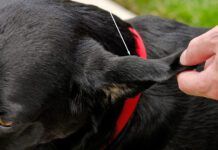I thoroughly enjoyed the article “Stop the Panic” by Gregory Tilford in the September 2003 issue. Gregory mentioned a liquid extract formula that combines valerian, skullcap, oat flower, and passionflower. Can you tell me what the name of that formula is?
I have a very high energy one-year-old Labrador who gets very excited whenever I get the leash out for dog training classes or even for walks. He whines so loudly it’s hard to believe he can hear me when I ask him to sit above all that noise, but he is very obedient. Possibly he is lip reading?
I also wonder why Greg did not include the Bach Flower Essence “Rescue Remedy” in his article.
-Deby
via e-mail
Tilford was talking about his own company’s product: Animals Apawthecary’s “Tranquillity Blend.” Tilford is modest about his own work, and reluctant to promote his own products over others that may be available. Animals Apawthecary’s products may be purchased from Animal Essentials (888- 551-0416 or www.animalessentials.com, click on “buy products” and then “Animals’ Apawthecary”).
Don’t confuse flower essence remedies with herbal remedies. Flower essence remedies are highly diluted preparations, similar to homeopathic remedies in that they contain little of the original phytochemicals found in their source plants. Tilford is an herbalist.
WDJ has published an article on flower essence remedies (“Flower Power” March 1999) and also discussed them (and “Rescue Remedy” in particular) in “When the Thunder Rolls,” April 2000. Looks like we’re due for a new article on the topic.
———-
Thanks so much for the article on Addison’s disease (“The Great Pretender,” February 2003). Little did I know when I read it in February that I would need that information in August. My beloved three-year-old Bull Terrier was diagnosed with Addison’s after nearly dying from a cardiac arrhythmia secondary to a high potassium level. I gave your article to my local vet and the vet at Colorado State University Veterinary Teaching Hospital. The information in the article helped me enormously.
-Betsy Cullen, nurse practitioner
via e-mail
We’re so glad that article helped. As you learned, Addison’s is one of the most frequently misdiagnosed life-threatening diseases. Readers, save those back issues! You never know when you will need them.
———-
Thanks for the outstanding article about deaf dogs in the September 2003 issue (“Deaf-Initely Trainable”). It was a great pleasure to read such a positive and accurate article. One of my dog companions is a deaf Australian Cattle Dog. She is so smart, well-behaved, and happy. I hope that excellent information such as that in your article will help dispel some of the myths about deaf dogs and enable more of them to find loving homes.
-Lynda
via e-mail
———-
As the owner of a unilaterally deaf Australian Shepherd, I just had to write and thank you for the article on deaf dogs. Similar to Dr. Sell’s experience with her first deaf dog, our journey into the deaf dog world was unplanned. Frankie (our deaf Aussie) has shared our lives for over three years. We can’t imagine life without him.
I would also like to applaud Jack Edward’s description of “special needs” as it relates to deaf dogs. Truly, we do not think of Frankie as a special needs dog. Being deaf is simply part of being “Frankie.” Since he was our first deaf dog, we were originally very concerned about being able to communicate with him. Very quickly, we learned our concern was completely unfounded. Quite simply, we rarely think about his deafness. Frankie communicates quite well, both in the canine and human world.
Our lives are forever changed, and we remain indebted to Frankie for the lessons he has taught us. We are also grateful to the deaf dog community at large as a source of support, education, and friendship.
-Brenda Hutton
Glendale, Arizona
———-
Thanks for the very informative article on deaf dogs. I hope that you’ll consider including an article on another group of differently abled dogs: blind dogs. Sadly, they too are often euthanized due to their disability, or not given all of the opportunities open to other dogs. But as my blind Great Dane, Sapphire, clearly demonstrates, they can keep up with their sighted counterparts, and have a very active, enjoyable life.
Sapphire, who just turned four years old, had been brought into a vet clinic to be euthanized due to her disability. Fortunately, she made her way to a rescue group instead, and eventually we found each other when she was 16 months old. She is now active as a therapy dog, visiting the VA hospital and senior homes.
In addition, as of June 1, she was the 12th ranked APDT Rally Obedience dog in the country. She earned her first Rally Obedience title in January of this year, and has two legs towards her second title, which is all off-leash. We have started working on agility. She thoroughly enjoyed a two-day Canine Freestyle workshop, and will soon be starting a Canine Freestyle class.
I hope that those in doubt can be encouraged to realize that being blind does not need to keep a dog from living a full, happy life.
-Jeri and Sapphire
via e-mail
Wow! It’s amazing what we learn from our readers. We’ll start working on an article regarding the care and training of blind dogs.





